SEJournal Online is the digital news magazine of the Society of Environmental Journalists. Learn more about SEJournal Online, including submission, subscription and advertising information.
 |
| The federal government publishes data specifying designated highway hazmat routes that reporters can use to prepare for future toxic transport spills. Above, the recent train derailment in East Palestine, Ohio. Photo: Felton Davis via Flickr Creative Commons (CC BY 2.0). |
Reporter’s Toolbox: Hazmat Highway Routes Key to Keeping Public Safe
By Joseph A. Davis
We watched ominous black clouds tower over the train derailment in East Palestine, Ohio. Then we watched the town’s residents agonize over the possibility of toxic chemicals remaining to harm their health.
And we have listened to many people, some of them journalists, perform outrage over how such a thing could be allowed to happen.
Pro tip: It will happen again. The trick is being ready.
And fortunately, there’s a database for that.
For this Toolbox, we’ll look primarily at data related to highways (and yes, there are also data on railroad hazmat routes; more on that below).
Whatever your location, there are
designated hazardous materials routes
set by law for highway transportation.
Whatever your location, there are designated hazardous materials routes set by law for highway transportation. The Transportation Department publishes data specifying all the designated routes nationwide.
Check it out here (this state-by-state table makes it even easier to use). It can be a starting point for both pre-disaster and post-disaster stories.
Where the data come from
Federal law requires the Federal Motor Carrier Safety Administration to publish these routes. FMCSA and its fellow Department of Transportation agency, the Pipeline and Hazardous Materials Safety Administration, or PHMSA, work with the states to figure out the safest routes for motor transport of different hazmats.
The result is the National Hazardous Materials Route Registry. This database is updated regularly but make sure your route of concern is current.
As to rail hazmat routes, the railroads have more say-so on it because tracks go where they go. More than a decade ago (when 100-car oil trains started blowing up) there was a struggle over whether railroads should disclose their hazmat routes. The resolution was that railroads had to disclose the routes to the Federal Railroad Administration.
But while the FRA had to disclose it to the states (not the public), the states could choose whether to disclose it to the public. The railroad lobby urged states not to disclose it publicly. Some states disclose it, some don’t.
The Society of Environmental Journalists has taken an official position in favor of disclosure. Check to see if they are disclosed in your state.
How to use the data smartly
Back to the highway hazmat data — it means a lot more if you can examine it via maps. Fortunately, the FMCSA will give you its routing data in Google map form. This is the wellspring of many stories. You can use Google and squint at the maps.
If you like playing with GIS data (or have a collaborator who does) you can overlay the map of hazmat routes with other mappable data: demographics (for environmental justice stories, for instance), nursery schools, other schools, nursing homes, Native lands, drinking water, beaches … whatever. Both highways and railroads go past these features.
Think defensively. Where are the drinking water sources? The water treatment plants? The power plants? Where do they park chlorine tank cars on the way to the water plants? Where are the fish and wildlife that a toxic spill could harm?
Now think of a jack-knifed gasoline tanker truck in a traffic jam or accident — or both.
Joseph A. Davis is a freelance writer/editor in Washington, D.C. who has been writing about the environment since 1976. He writes SEJournal Online's TipSheet, Reporter's Toolbox and Issue Backgrounder, and curates SEJ's weekday news headlines service EJToday and @EJTodayNews. Davis also directs SEJ's Freedom of Information Project and writes the WatchDog opinion column.
* From the weekly news magazine SEJournal Online, Vol. 8, No. 8. Content from each new issue of SEJournal Online is available to the public via the SEJournal Online main page. Subscribe to the e-newsletter here. And see past issues of the SEJournal archived here.













 Advertisement
Advertisement 



